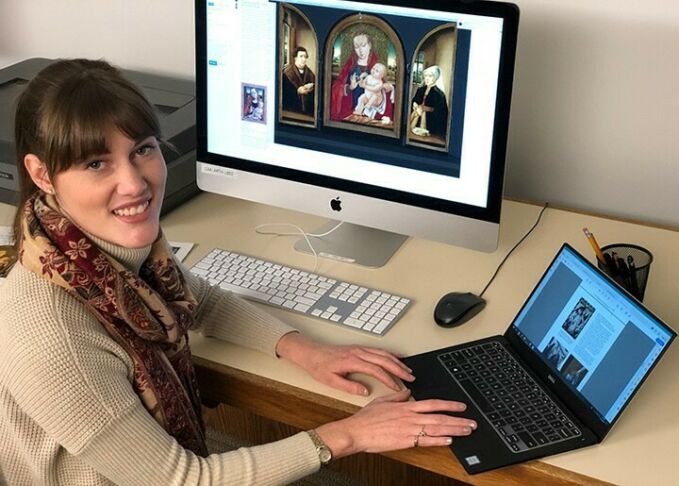October 01, 2019
Art History grad student's website embraces the digital future of the discipline

After the triptych "Virgin and Child with Two Donors," a piece in the permanent collection of the Palmer Museum of Art, was discovered to be a forgery, Carolyn Lucarelli, curator of visual resources in the Department of Art History's Visual Resources Centre, saw an opportunity to advance digital humanities at Penn State. Graduate assistant Emily Hagen answered the call.
After nearly one year of work, Hagen has completed "How to Make a Fake," an interactive website devoted to her comprehensive analysis of the forged triptych believed to be a work created in the 1400s by the Netherlandish painter Hans Memling.
On the website, the first of its kind produced by the Department of Art History, visitors can learn the story of how Metropolitan Museum of Art curator Maryann Ainsworth discovered the forgery and gain a better understanding of the work's inconsistencies by clicking on various reference points mapped on an image of the triptych.
The site offers not only a fascinating look into the history of the triptych, but also is an example of the digital tools art historians can employ to move the field beyond analog analysis, according to Elizabeth Mansfield, head of the Department of Art History.
"With this project, Emily is showing us how digital methods can be used to advance research in art history and to enhance public engagement," Mansfield said. "Art historians have been slow to embrace digital and computational methods in part because their training and aesthetic sensibilities make them especially critical viewers of things like data visualizations and manipulated digital images‚ but Emily's work merges those traits with digital tools in a convincing way that supports pursuing digital art scholarship at Penn State."
When Hagen began her work on the project in the VRC, under the supervision of Lucarelli, she had a basic understanding of web building tools, but quickly realized that to create a tool that geo-locates the work's inconsistencies she was going to need some help.
"To achieve the results that I hoped for, I tapped into several resources from outside of our department and college," Hagen said. "Having the opportunity to make and enhance those connections created a diverse network, which I think is a strength of the project."
The success achieved within the interdisciplinary culture at Penn State highlights what Mansfield and Lucarelli believe provides the support structure for developing permanent digital scholarship in the Department of Art History.
In the last decade, the VRC has been digitizing the Department of Art History's analog assets and faculty have embraced the digital pedagogical tools. However, to fully realize the potential of the field, more projects like Hagen's are necessary to position Penn State as a digital art history leader in higher education, Mansfield said.
As work progressed on the project, Hagen and Lucarelli developed a collaborative relationship with John Russell, associate director of the Center for Humanities and Information. Russell is responsible for digital scholarship in the University Libraries and since helping with an art history graduate seminar in digital art history in 2017, he has secured grant funding to support graduate assistantships that will focus on digital humanities in relation to the visual arts. The research is expected to lead to the development of a course that would be offered in the Department of Art History in conjunction with the University Libraries, according to Mansfield.
"This is just one way that we are working with colleagues across Penn State to develop methods that address data collection, structuring and visualization in the Department of Art History," Mansfield said. "And as digital methodologies in the field advance, we want to be able to look back and see that this department and Penn State played a very strong role in moving along the wider discipline."
As the Department of Art History works toward its digital goals, Hagen's work will remain as an early example of the possibilities, which Hagen said is a gratifying end to a project in which she was deeply invested.
"The combination of freedom to dive into this project and the collaborative support resulted in a final product that, honestly, exceeds my expectations," Hagen said. "It was a fun project that enriched my learning experience. And the possibility of the work advancing digital art history resources at Penn State is something I will always be proud of."
